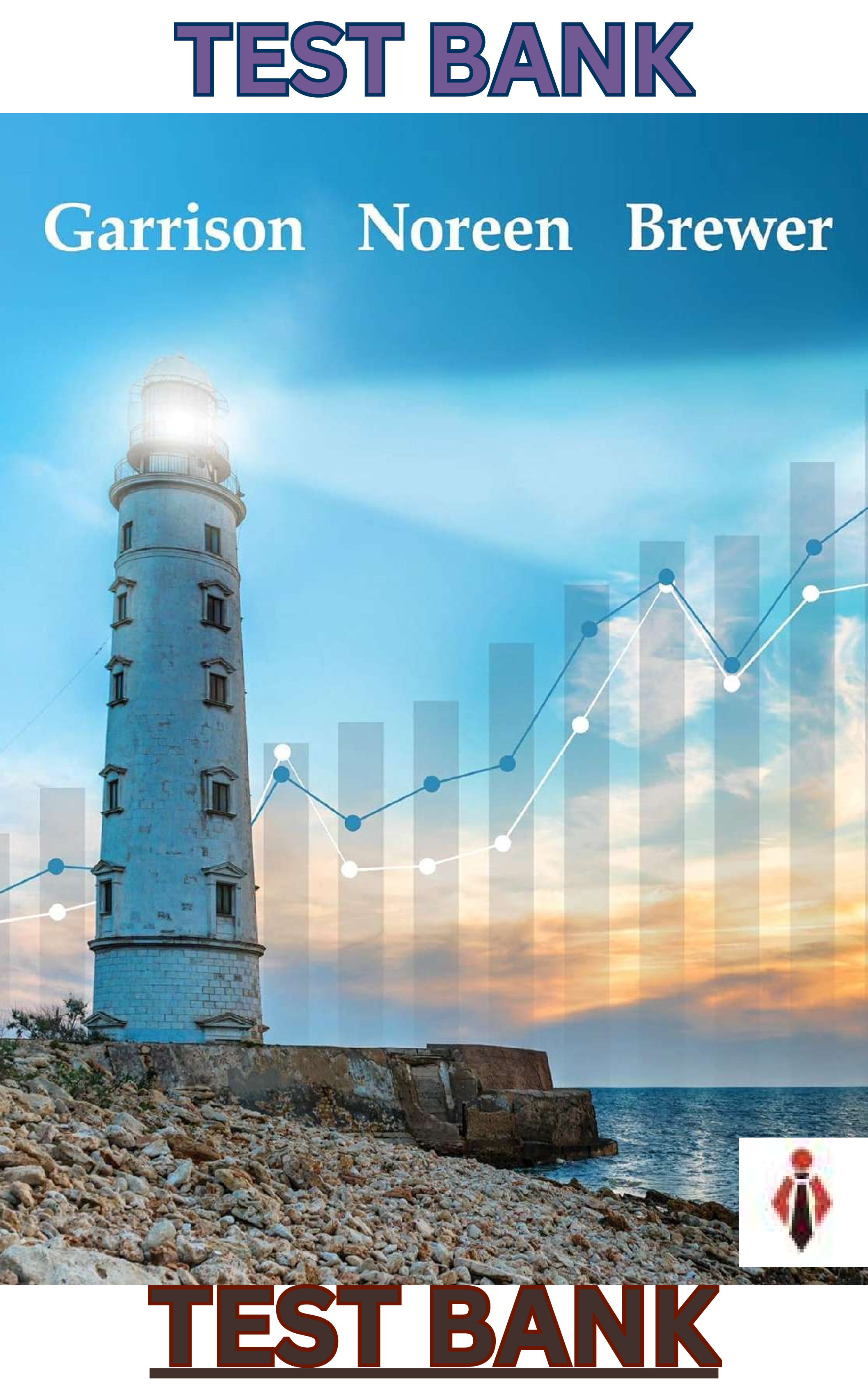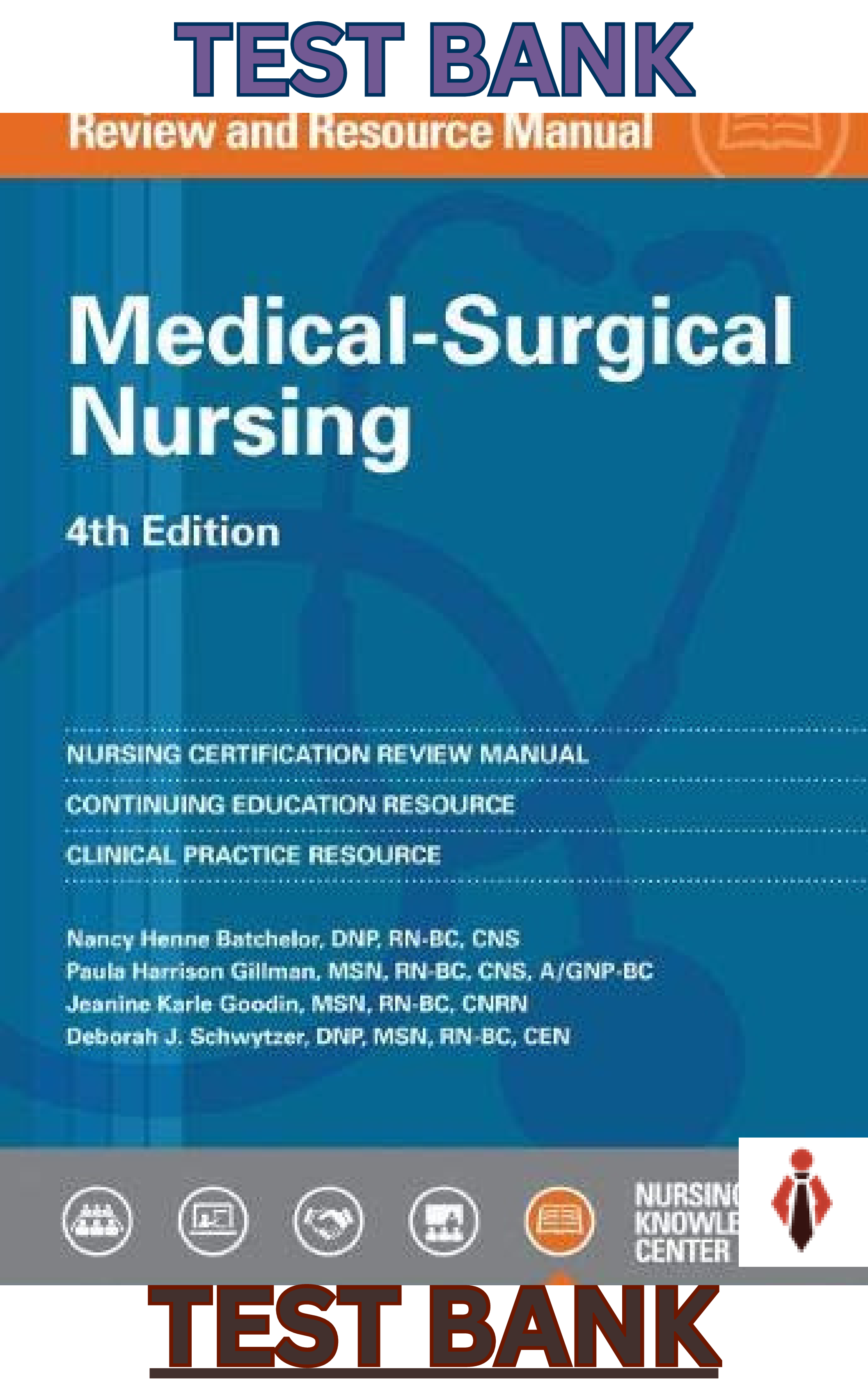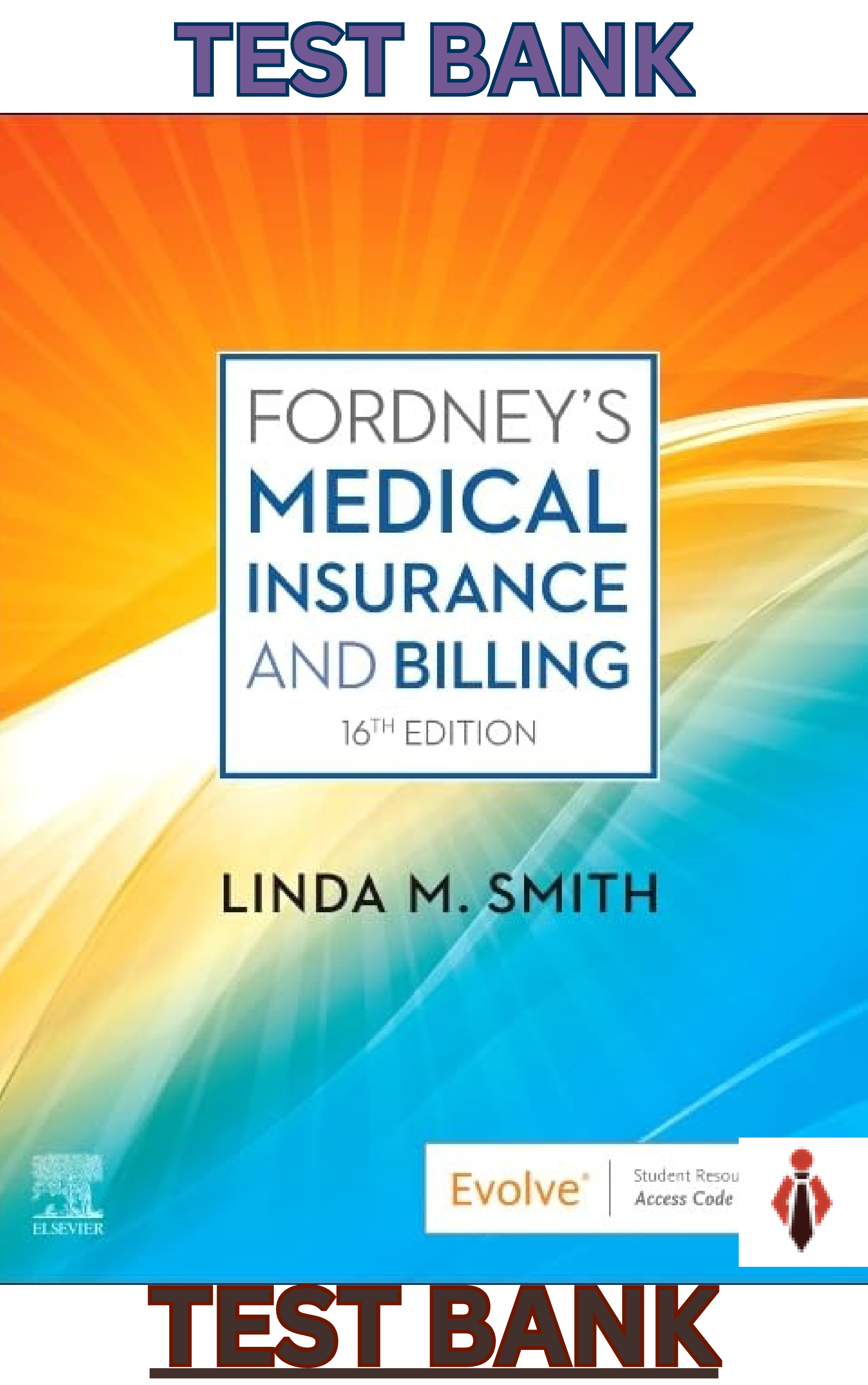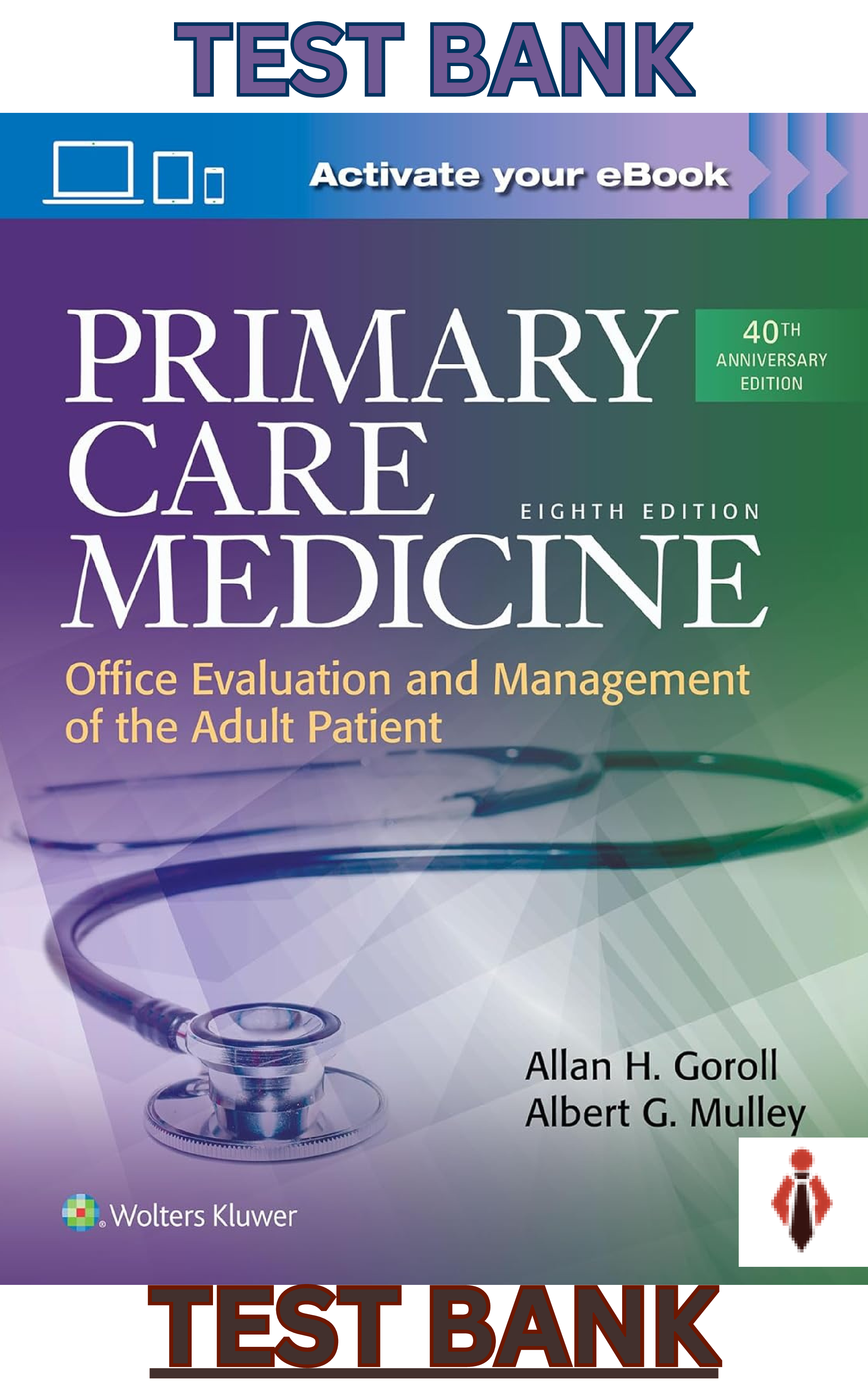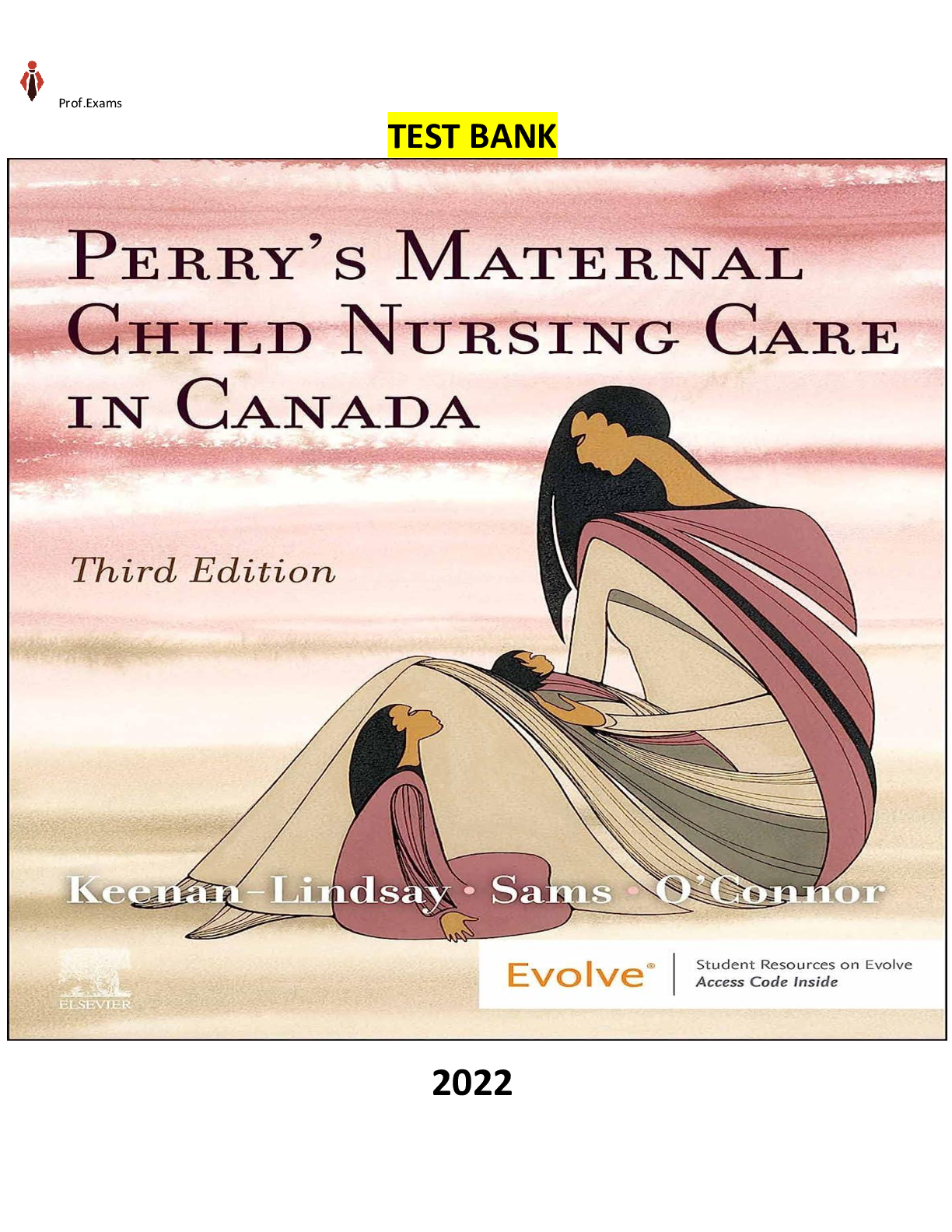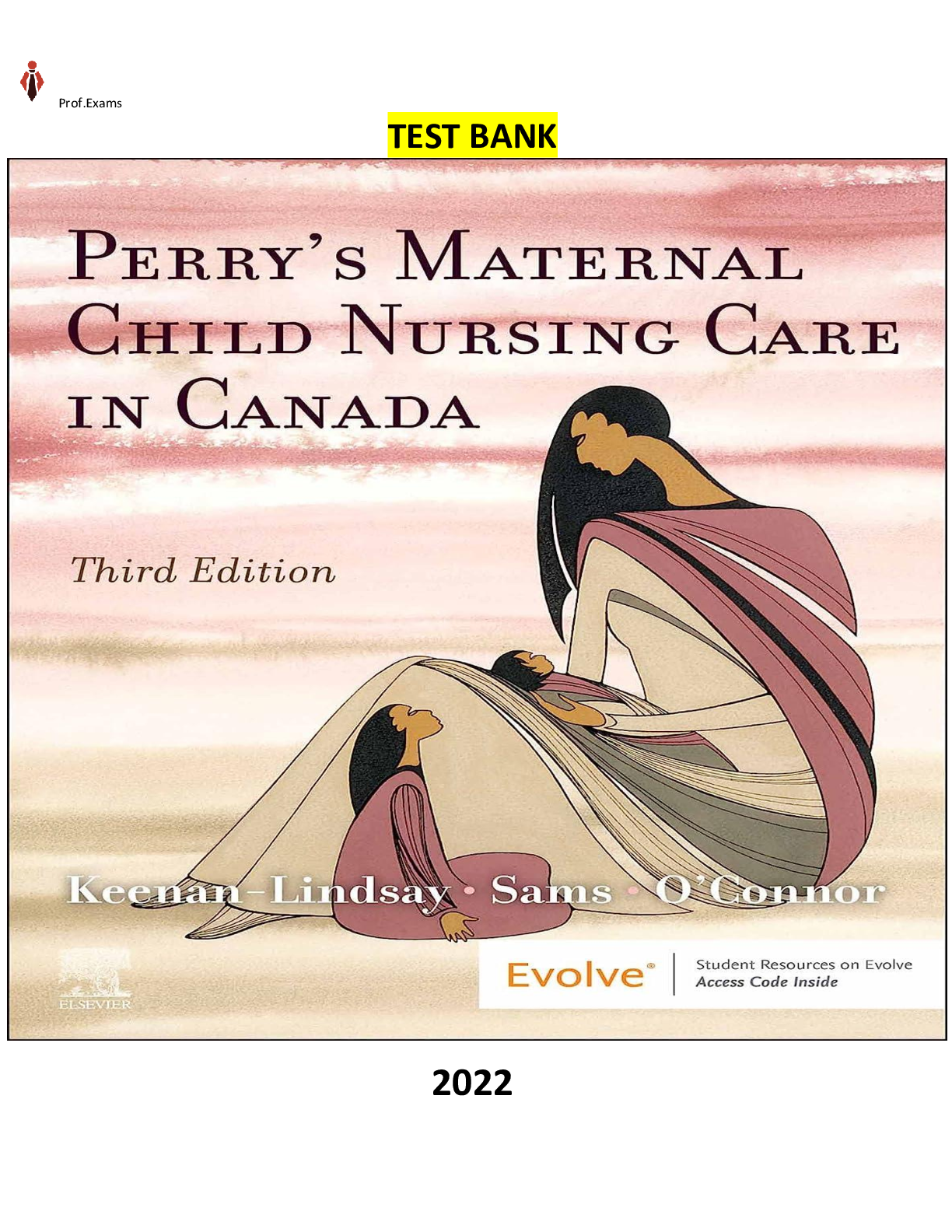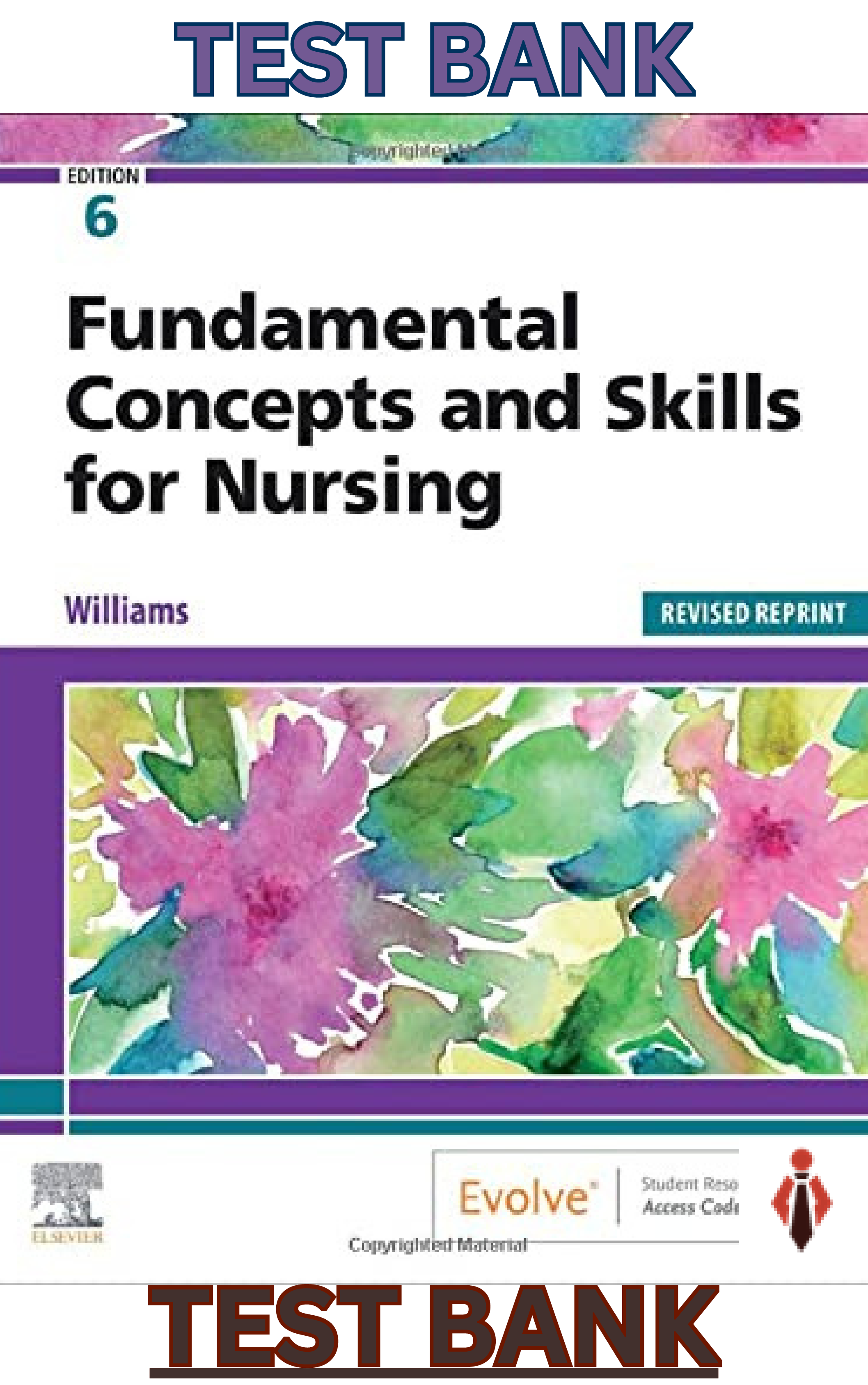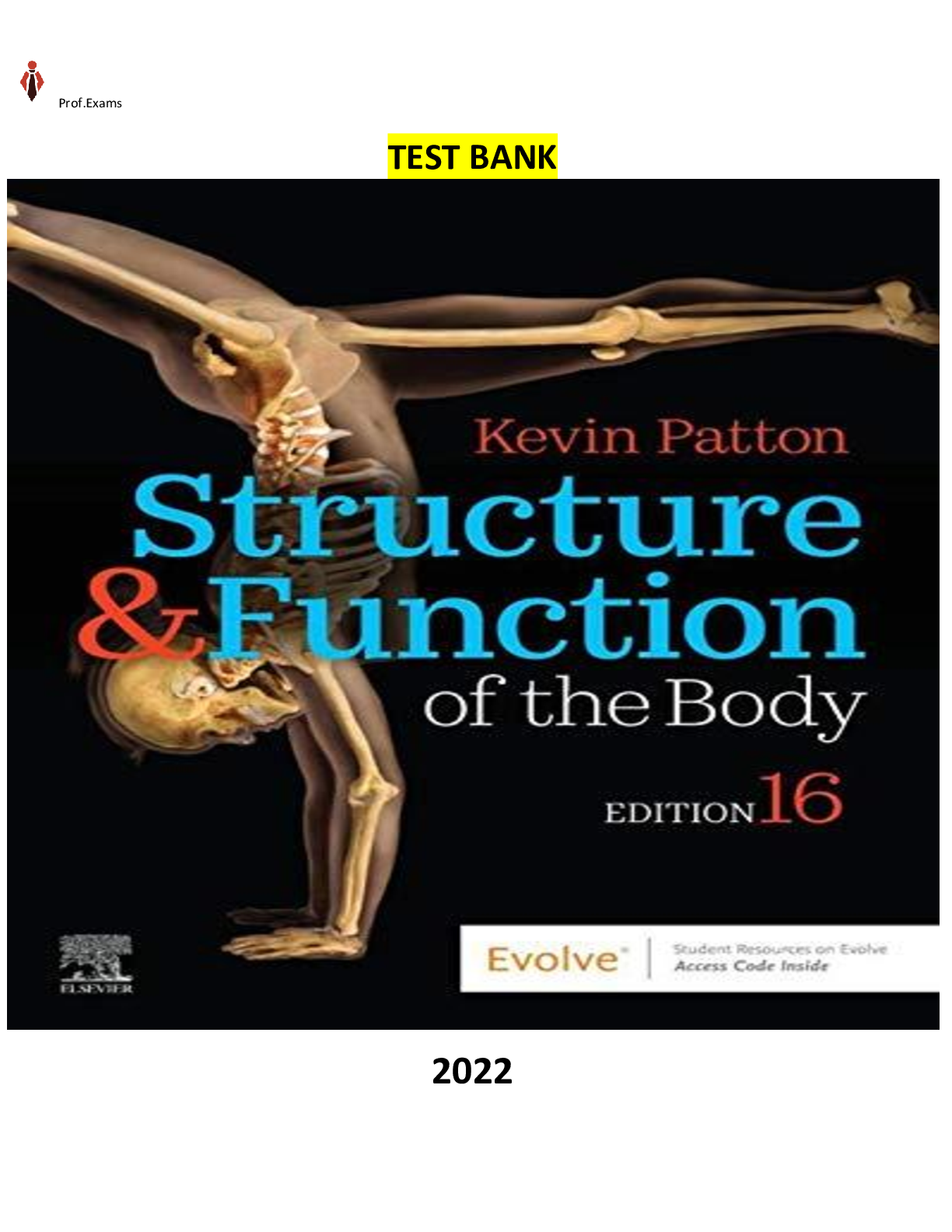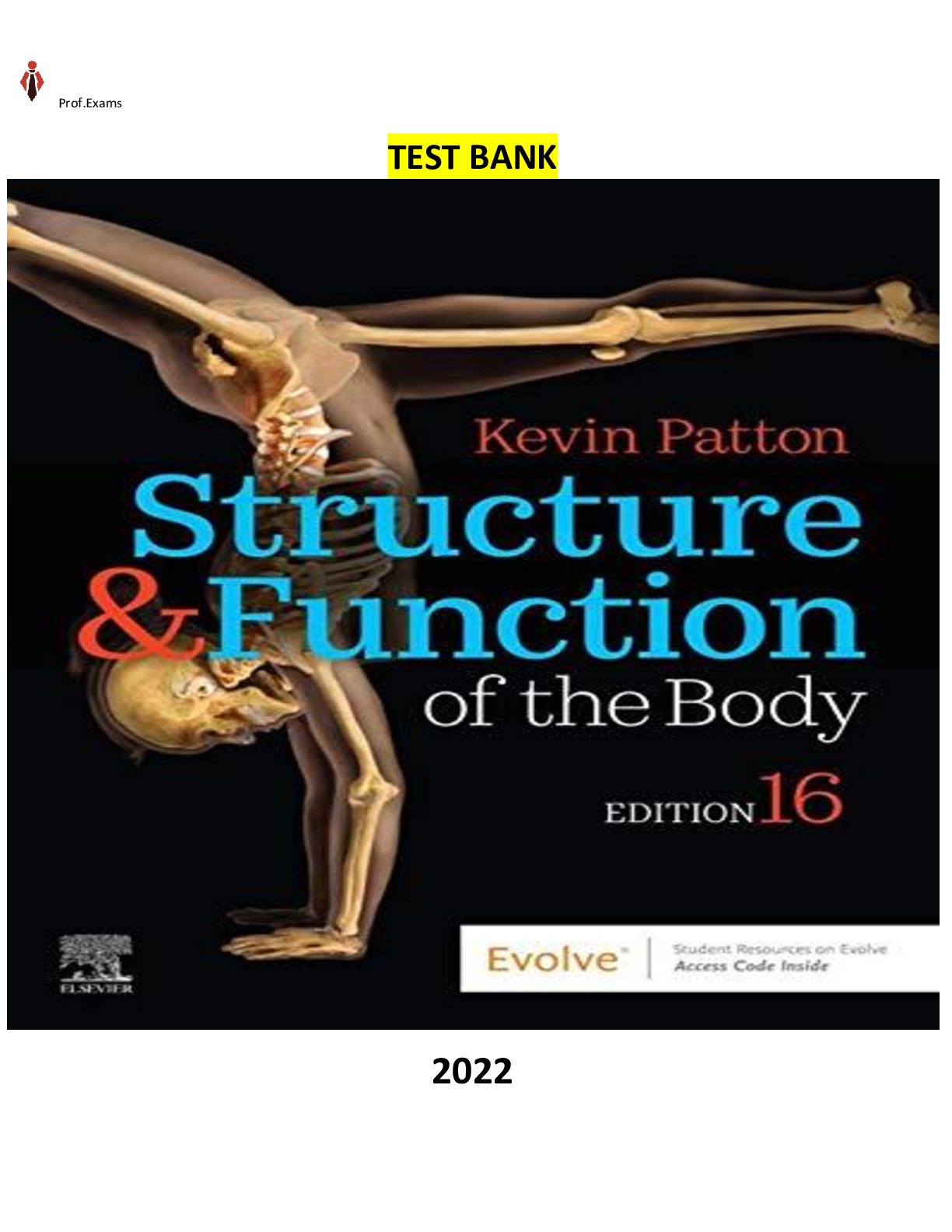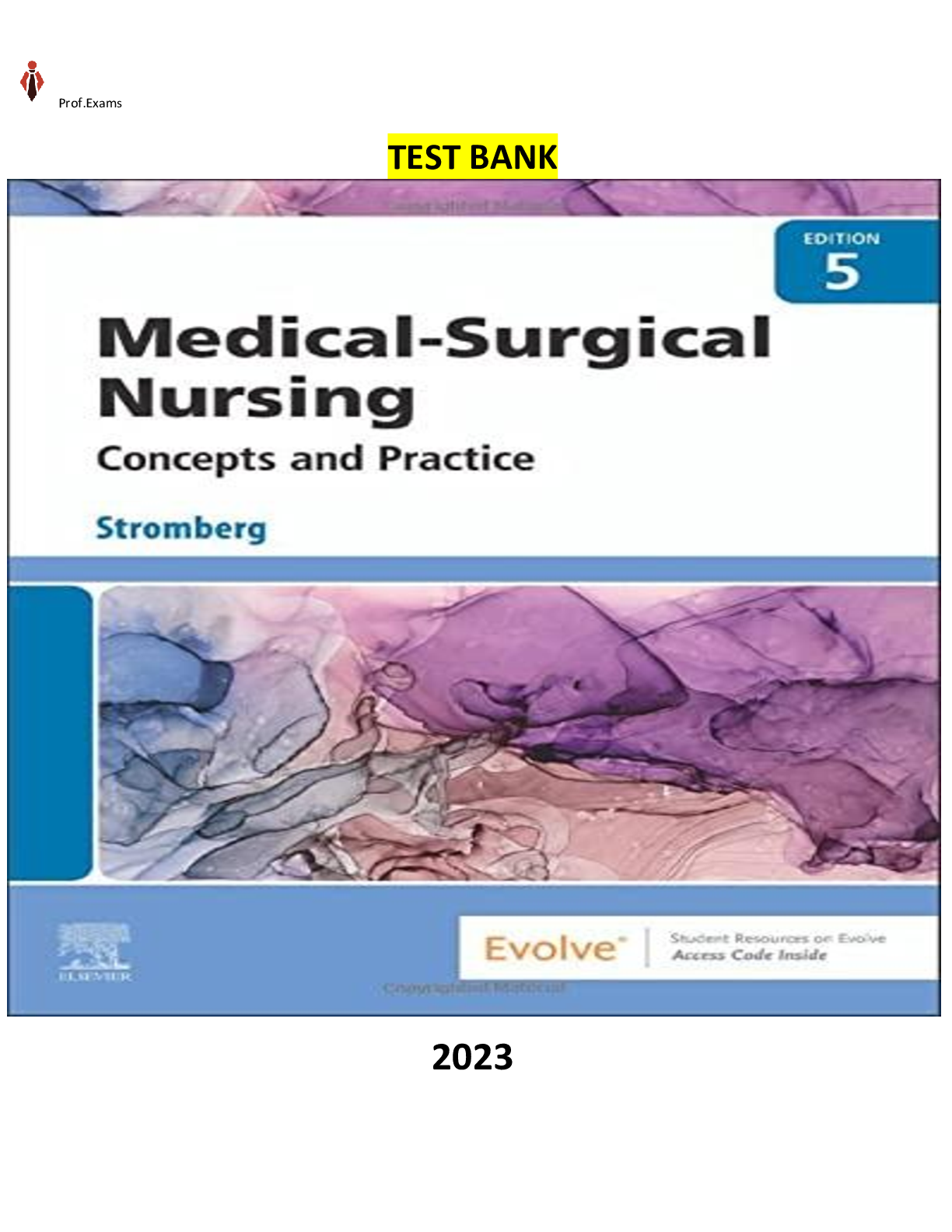Pharmacology > TEST BANK > COMPLETE - Elaborated Test Bank for Focus on Nursing Pharmacology, 6Ed.by Amy Karch & R. N. Lynn-Pam (All)
COMPLETE - Elaborated Test Bank for Focus on Nursing Pharmacology, 6Ed.by Amy Karch & R. N. Lynn-Pamela .ALL Chapters (1-48)included with 846 pages of questions.
Document Content and Description Below
COMPLETE - Elaborated Test Bank for Focus on Nursing Pharmacology, 6Ed.by Amy Karch & R. N. Lynn-Pamela.ALL Chapters (1-48)included 846 pages of questions. TABLE OF CONTENTS PT. 1. INTRODUCTION TO... NURSING PHARMACOLOGY. INTRODUCTION TO DRUGS 1. Drugs and the body 2. Toxic effects of drugs 3. The nursing process in drug therapy and patient safety 4. Dosage calculations 5. Challenges to effective drug therapy PT. 2. CHEMOTHERAPEUTIC AGENTS. INTRODUCTION TO CELL PHYSIOLOGY 6. Anti-infective agents 7. Antibiotics 8. Antiviral agents 9. Antifungal agents 10. Antiprotozoal agents 11. Anthelmintic agents 12. Antineoplastic agents PT. 3. DRUGS ACTING ON THE IMMUNE SYSTEM. INTRODUCTION TO THE IMMUNE RESPONSE AND INFLAMMATION 13. Anti-inflammatory, antiarthritis, and related agents 14. Immune modulators 15. Vaccines and sera PT. 4. DRUGS ACTING ON THE CENTRAL AND PERIPHERAL NERVOUS SYSTEMS. INTRODUCTION TO NERVES AND THE NERVOUS SYSTEM 16. Anxiolytic and hypnotic agents 17. Antidepressant agents 18. Psychotherapeutic agents 19. Antiseizure agents 20. Anti-parkinsonism agents 21. Muscle relaxants 22. Narcotics, narcotic antagonists, and antimigraine agents 23. General and local anesthetic agents 24. Neuromuscular junction blocking agents PT. 5. DRUGS ACTING ON THE AUTONOMIC NERVOUS SYSTEM. INTRODUCTION TO THE AUTONOMIC NERVOUS SYSTEM 25. Adrenergic agonists 26. Adrenergic blocking antagonists. 27. Cholinergic agonists 28. Anticholinergic agents PT. 6. DRUGS ACTING ON THE ENDOCRINE SYSTEM. INTRODUCTION TO THE ENDOCRINE SYSTEM 29. Hypothalamic and pituitary agents 30. Adrenocortical agents 31. Thyroid and parathyroid agents 32. Agents to control blood glucose levels PT. 7. DRUGS ACTING ON THE REPRODUCTIVE SYSTEM. INTRODUCTION TO THE REPRODUCTIVE SYSTEM 33. Drugs affecting the female reproductive system 34. Drugs affecting the male reproductive system PT. 8. DRUGS ACTING ON THE CARDIOVASCULAR SYSTEM. INTRODUCTION TO THE CARDIOVASCULAR SYSTEM 35. Drugs affecting blood pressure 36. Cardiotonic agents 37. Antiarrhythmic agents 38. Antianginal agents 39. Lipid-lowering agents 40. Drugs affecting blood coagulation 41. Drugs used to treat anemias PT. 9. DRUGS ACTING ON THE RENAL SYSTEM. INTRODUCTION TO THE RENAL SYSTEM 42. Diuretic agents 43. Drugs affecting the urinary tract and the bladder. PT. 10. DRUGS ACTING ON THE RESPIRATORY SYSTEM. INTRODUCTION TO THE RESPIRATORY SYSTEM 44. Drugs acting on the upper respiratory tract 45. Drugs acting on the lower respiratory tract PT. 11. DRUGS ACTING ON THE GASTROINTESTINAL SYSTEM. INTRODUCTION TO THE GASTROINTESTINAL SYSTEM 46. Drugs affecting gastrointestinal secretions 47. Drugs affecting gastrointestinal motility 48. Antiemetic agents 1. A nurse working in radiology administers iodine to a patient who is having a computed tomography (CT) scan. The nurse working on the oncology unit administers chemotherapy to patients who have cancer. At the Public Health Department, a nurse administers a measles-mumps-rubella (MMR) vaccine to a 14-month-old child as a routine immunization. Which branch of pharmacology best describes the actions of all three nurses? A) Pharmacoeconomics B) Pharmacotherapeutics C) Pharmacodynamics D) Pharmacokinetics Ans: B Feedback: Pharmacology is the study of the biologic effects of chemicals. Nurses are involved with clinical pharmacology or pharmacotherapeutics, which is a branch of pharmacology that deals with the uses of drugs to treat, prevent, and diagnose disease. The radiology nurse is administering a drug to help diagnose a disease. The oncology nurse is administering a drug to help treat a disease. Pharmacoeconomics includes any costs involved in drug therapy. Pharmacodynamics involves how a drug affects the body and pharmacokinetics is how the body acts on the body. 2. A physician has ordered intramuscular (IM) injections of morphine, a narcotic, every 4 hours as needed for pain in a motor vehicle accident victim. The nurse is aware this drug has a high abuse potential. Under what category would morphine be classified? A) Schedule I B) Schedule II C) Schedule III D) Schedule IV Ans: B Feedback: Narcotics with a high abuse potential are classified as Schedule II drugs because of severe dependence liability. Schedule I drugs have high abuse potential and no accepted medical use. Schedule III drugs have a lesser abuse potential than II and an accepted medical use. Schedule IV drugs have low abuse potential and limited dependence liability. Page 2 3. When involved in phase III drug evaluation studies, what responsibilities would the nurse have? A) Working with animals who are given experimental drugs B) Choosing appropriate patients to be involved in the drug study C) Monitoring and observing patients closely for adverse effects D) Conducting research to determine effectiveness of the drug Ans: C Feedback: Phase III studies involve use of a drug in a vast clinical population in which patients are asked to record any symptoms they experience while taking the drugs. Nurses may be responsible for helping collect and analyze the information to be shared with the Food and Drug Administration (FDA) but would not conduct research independently because nurses do not prescribe medications. Use of animals in drug testing is done in the preclinical trials. Select patients who are involved in phase II studies to participate in studies where the participants have the disease the drug is intended to treat. These patients are monitored closely for drug action and adverse effects. Phase I studies involve healthy human volunteers who are usually paid for their participation. Nurses may observe for adverse effects and toxicity. 4. What concept is considered when generic drugs are substituted for brand name drugs? A) Bioavailability B) Critical concentration C) Distribution D) Half-life Ans: A Feedback: Bioavailability is the portion of a dose of a drug that reaches the systemic circulation and is available to act on body cells. Binders used in a generic drug may not be the same as those used in the brand name drug. Therefore, the way the body breaks down and uses the drug may differ, which may eliminate a generic drug substitution. Critical concentration is the amount of a drug that is needed to cause a therapeutic effect and should not differ between generic and brand name medications. Distribution is the phase of pharmacokinetics, which involves the movement of a drug to the body's tissues and is the same in generic and brand name drugs. A drug's half-life is the time it takes for the amount of drug to decrease to half the peak level, which should not change when substituting a generic medication. Page 3 5. A nurse is assessing the patient's home medication use. After listening to the patient list current medications, the nurse asks what priority question? A) ―Do you take any generic medications?‖ B) ―Are any of these medications orphan drugs?‖ C) ―Are these medications safe to take during pregnancy?‖ D) ―Do you take any over-the-counter medications?‖ Ans: D Feedback: It is important for the nurse to specifically question use of over-the-counter medications because patients may not consider them important. The patient is unlikely to know the meaning of ―orphan drugs‖ unless they too are health care providers. Safety during pregnancy, use of a generic medication, or classification of orphan drugs are things the patient would be unable to answer but could be found in reference books if the nurse wishes to research them. 6. After completing a course on pharmacology for nurses, what will the nurse know? A) Everything necessary for safe and effective medication administration B) Current pharmacologic therapy; the nurse will not require ongoing education for 5 years. C) General drug information; the nurse can consult a drug guide for specific drug information. D) The drug actions that are associated with each classification of medication Ans: C Feedback: After completing a pharmacology course nurses will have general drug information needed for safe and effective medication administration but will need to consult a drug guide for specific drug information before administering any medication. Pharmacology is constantly changing, with new drugs entering the market and new uses for existing drugs identified. Continuing education in pharmacology is essential to safe practice. Nurses tend to become familiar with the medications they administer most often, but there will always be a need to research new drugs and also those the nurse is not familiar with because no nurse knows all medications. Page 4 7. A nurse is instructing a pregnant patient concerning the potential risk to her fetus from a Pregnancy Category B drug. What would the nurse inform the patient? A) ―Adequate studies in pregnant women have demonstrated there is no risk to the fetus.‖ B) ―Animal studies have not demonstrated a risk to the fetus, but there have been no adequate studies in pregnant women.‖ C) ―Animal studies have shown an adverse effect on the fetus, but there are no adequate studies in pregnant women.‖ D) ―There is evidence of human fetal risk, but the potential benefits from use of the drug may be acceptable despite potential risks.‖ Ans: B Feedback: Category B indicates that animal studies have not demonstrated a risk to the fetus. However, there have not been adequate studies in pregnant women to demonstrate risk to a fetus during the first trimester of pregnancy and no evidence of risk in later trimesters. Category A indicates that adequate studies in pregnant women have not demonstrated a risk to the fetus in the first trimester or in later trimesters. Category C indicates that animal studies have shown an adverse effect on the fetus, but no adequate studies in humans. Category D reveals evidence of human fetal risk, but the potential benefits from the use of the drugs in pregnant women may outweigh potential risks. 8. Discharge planning for patients leaving the hospital should include instructions on the use of over-the-counter (OTC) drugs. Which comment by the patient would demonstrate a good understanding of OTC drugs? A) ―OTC drugs are safe and do not cause adverse effects if taken properly.‖ B) ―OTC drugs have been around for years and have not been tested by the Food and Drug Administration (FDA).‖ C) ―OTC drugs are different from any drugs available by prescription and cost less.‖ D) ―OTC drugs could cause serious harm if not taken according to directions.‖ Ans: D Feedback: It is important to follow package directions because OTCs are medications that can cause serious harm if not taken properly. OTCs are drugs that have been determined to be safe when taken as directed; however, all drugs can produce adverse effects even when taken properly. They may have originally been prescription drugs that were tested by the FDA or they may have been grandfathered in when the FDA laws changed. OTC education should always be included as a part of the hospital discharge instructions. Page 5 9. What would be the best source of drug information for a nurse? A) Drug Facts and Comparisons B) A nurse's drug guide C) A drug package insert D) The Physicians' Drug Reference (PDR) Ans: B Feedback: A nurse's drug guide provides nursing implications and patient teaching points that are most useful to nurses in addition to need-to-know drug information in a very user friendly organizational style. Lippincott's Nursing Drug Guide (LNDG) has drug monographs organized alphabetically and includes nursing implications and patient teaching points. Numerous other drug handbooks are also on the market and readily available for nurses to use. Although other drug reference books such as Drug Facts and Comparisons, PDR, and drug package inserts can all provide essential drug information, they will not contain nursing implications and teaching points and can be more difficult to use than nurse's drug guides. 10. The nurse is preparing to administer a medication from a multidose bottle. The label is torn and soiled but the name of the medication is still readable. What is the nurse's priority action? A) Discard the entire bottle and contents and obtain a new bottle. B) Find the drug information and create a new label for the bottle. C) Ask another nurse to verify the contents of the bottle. D) Administer the medication if the name of the drug can be clearly read. Ans: A Feedback: When the drug label is soiled obscuring some information the safest action by the nurse is to discard the bottle and contents because drug labels contain a great deal of important information, far more than just the name of the drug. Concentration of the drug, expiration date, administration directions, and precautions may be missing from the label and so put the patient at risk. Looking up drug information in a drug handbook or consulting with another nurse will not supply the expiration date or concentration of medication. Be safe and discard the bottle and its contents. [Show More]
Last updated: 1 year ago
Preview 1 out of 851 pages

Reviews( 0 )
Document information
Connected school, study & course
About the document
Uploaded On
Apr 25, 2023
Number of pages
851
Written in
Additional information
This document has been written for:
Uploaded
Apr 25, 2023
Downloads
0
Views
58

